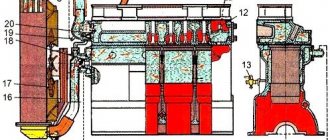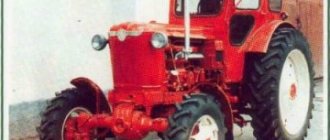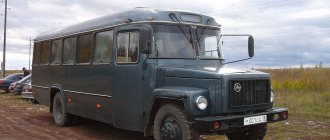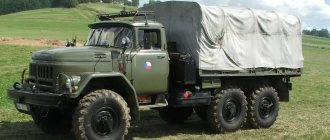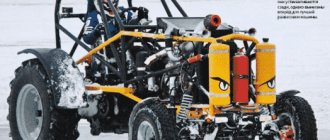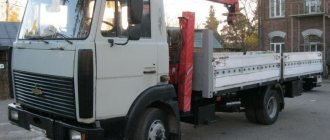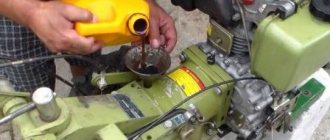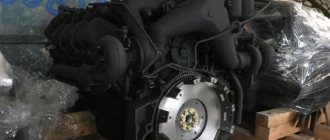Among the variety of tractors developed by the USSR industry, the products of the Southern Machine-Building Plant in Dnepropetrovsk (now Dnepr) stand out. Created in the late 60s. The YuMZ tractor with the YuMZ-6 marking was produced at the enterprise until 2001; the machine in various modifications was considered the best in the country in its class. It was also highly regarded in the West, and Sweden even officially acquired the technical documentation, using it to start producing its own equipment.
YuMZ-6 is a representative of universal wheeled tractors for general purpose, part of the “Belarus” line, initially produced by the tractor plant in Minsk, but later developed at YuMZ.
History of creation
In the USSR, there was a widespread practice when equipment developed in the design bureau of one enterprise was mastered by another enterprise from the same field, and was produced either under the original brand or under the own name of the successor plant. The prototype of the YuMZ-6 tractor was the Minsk Tractor Machine. Since 1958, the production of this tractor was mastered at YuMZ, the markings did not change. Technological continuity was preserved; the original design of the tractor developed by MTZ remained unchanged.
MTZ-5, prototype of the Yuzhmash tractor. Archive photo:
It is interesting that the Southern Machine-Building Plant was not initially conceived as a tractor plant.
According to the plan of the Soviet leadership, it was supposed to become an automobile enterprise, but in 1951, while still in the process of construction, it was repurposed for the production of rocketry, and tractor production was launched, pursuing two goals:
- hide the main line of activity from foreign intelligence;
- fill the state's need for tractor equipment.
At the end of the 60s, YuMZ created its own modification, which became a processing of MTZ-5. The new tractor received the YUMZ-6 marking, becoming a modernization of the original model from the Minsk plant. Prototypes were assembled in Dnepropetrovsk in 1966, and serial production began in 1970. After 2 years, the number of cars produced reached 100 thousand copies.
Over the years, the design of the tractor has been improved and refined. The manufacturer produced 4 modifications in series, which will be discussed below. Users noted the high performance characteristics, reliable and uncomplicated design of the tractor, which made it possible to service it even outside specialized enterprises.
Interesting: Foreign buyers were actively interested in YuMZ-6 and its modifications. Thus, it is noteworthy that in 1974 the Volvo concern acquired technical documentation for a tractor from the USSR and created the Volvo BM-700 unit on its basis. This tractor was in production from 1976 to 1982, and the Scandinavians noted its excellent performance in the difficult climatic conditions of their country.
Volvo BM-700:
The last YuMZ-6 left the workshop in 2001. The tractor was discontinued due to general obsolescence; it was replaced on conveyors by YuMZ-8040.2 and other, more modern models. But the solid “life” in production – over 30 years – convincingly indicates the successful design of the machine and its high potential, which has remained relevant for three decades. This is confirmed by many YuMZ-6 tractors, which are still in active use in agriculture and special work.
Oil consumption rates for tractors
Most engines of tractors and other special equipment have a certain oil consumption, so over time it needs to be topped up in order to protect the equipment from damage. The question of the amount of consumption is of interest to most equipment owners, so we will provide a table with this data, based on the main and popular tractor models in Russia. Also note that the consumption rate is taken from 100 liters of fuel.
The above table applies to working, serviceable tractor engines. But it should be understood that this figure will be higher if the engine and transmission are worn out. Consumption is also affected by indicators such as tractor load and weather conditions. Considering these features, you should check the oil level in time and add it.
Which oil do users recommend?
Many people advise using Mobile oil for a diesel engine; if possible, an alternative would be M-10B2. This option in many tractors shows a situation where viscosity is lost after heating. For the T-40 tractor, M10D oil is considered a good option; it has a good price and is changed approximately once a year. The D-65 tractor can work safely with the M10G2k oil option.
Recently, various additives have helped improve viscosity and extend engine life; according to experts, they increase engine life. The popular Molybdenum additive is poured in the ratio of 1 bottle per 7 liters of oil.
Purpose
The YuMZ unit belongs to the famous Belarus line of machines. The scope of his activities includes the following types of work:
- movement of goods;
- digging trenches and pits;
- loading and unloading operations;
- transportation of soil to the dump;
- formation of embankments;
- clearing areas of snow and debris;
- plowing of agricultural land;
- milling and loosening the soil;
- sowing crops;
- watering plants;
- fertilization;
- harvesting.
Tractor Yumz 6, general view
5.Modifications of the YuMZ-6 tractor
The YuMZ-6K tractor was produced from 1986 to 1993.
The Yuzhmash design bureau constantly worked to modernize equipment and improve its operational and economic characteristics. In total, during the history of the model’s existence, four modifications of tractors of the described series were produced:
YuMZ-6L. It was produced from 1970 to 1978 and differs little from the MTZ-5 in design. In terms of exterior, it is practically indistinguishable from its analogue, with the exception of the rounded radiator grille.
YuMZ-6AL. Rolled off the assembly line from 1978 to 1986. During the modernization, the instrument panel and radiator grille were changed, and the braking system was improved.
- YuMZ-6K. Produced from 1986 to 1993. It is an industrial modification of the model and does not have a rear attachment mechanism for agricultural implements. The machine has elements for attaching a bulldozer blade and excavator equipment.
- YuMZ-6AK. Gathered from 1993 to 2001. It differed from other models in its improved cabin design, larger glass area and folding windows. A steering column adjustment mechanism has been introduced.
The YuMZ-6AK tractor was produced from 1991 to 2001.
Indices are added to the indicated model markings indicating the type of starting system of the power unit: L - starting motor and M - electric starter. All of the above modifications of YuMZ-6 tractors were actively used in the national economy. Some machines are still in use, despite their venerable age, which indicates a large margin of safety.
Specifications
YuMZ-6 is a classic wheeled tractor. The design is based on a semi-frame consisting of a pair of side members and a transverse beam, on which the units and structural elements of the tractor are mounted.
The front axle is attached to the frame on hinges, and axles provide wheel rotation. At the rear, the tractor rests on the sleeves of the axle shafts, rigidly attached to the gearbox housing. This ensures simplicity of design with high reliability. The wheel arrangement of the YuMZ tractor is 4*2, with permanent rear-wheel drive.
The tractor has pneumatic wheels with low-pressure tires and powerful lugs - this gives it excellent maneuverability. Like other cars of a similar design, YuMZ-6 has different wheel diameters on the rear and front axles
- 7.5R20-9.0R20 front;
- 15.5R38 on the rear.
This is a typical solution that gives the tractor, together with rear-wheel drive, good cross-country ability and maneuverability.
Traction class YuMZ-6 – 1.4. This makes it suitable for use in various fields. The manufacturer has provided the possibility of expanding the functionality of the tractor:
- there is a separate-aggregate hydraulic system;
- the machine is equipped with a 12-volt on-board electrical system;
- there is a pneumatic system;
- a rear linkage is provided for connecting external equipment (in the picture below - that of the YuMZ-6KL tractor in the “agricultural” version).
Power point
The YuMZ line was equipped with diesel engines from the Rybinsk Aviation Plant D65M/N.
The letter depends on what kind of engine start the YuMZ 6 tractor has:
- M – started by electric starter;
- N – with start from a carburetor engine powered by an electric starter.
Due to the fact that the engines for the tractors were produced by a defense enterprise, their quality was at a high level, which increased their service life. The engines provide good traction for their class, are reliable and easy to operate and maintain, requiring, under normal conditions, only replacing the working fluids and adjusting the valves after 25 thousand kilometers.
But there were also disadvantages:
- the likelihood of lubricant leaks in components and joints;
- low speeds when comparing engines with similar ones;
- Motors are harmed by idling, which leads to accelerated wear.
Main parameters of D65 diesel engines:
| Engine power | 62 l. With. |
| Crankshaft speed, rpm. | 1750 |
| Cylinders | 4, in-line arrangement |
| Injection pump pressure, MPa | Not less than 17.5 |
| Weight | 525-540 kg. (depending on model) |
| Duration of tractor operation on one full tank filling | From 10 hours |
All engines are naturally aspirated and operate without turbocharging, which ensures simplicity of design and ease of maintenance. Cooling is liquid.
checkpoint
YuMZ-6 is equipped with a manual gearbox, which, in addition to moving forward, allows the tractor to move in reverse and transmit torque to the power take-off shaft: it is possible to operate the engine with the clutch engaged and the tractor stationary.
1 – primary shaft; 2 – coupling bolt; 3 – drive gear; 4 – pressure plates; 5, 31 – glasses; 6 – intermediate roller; 7 – adjusting gasket; 8 – ball bearing; 9 – gear for engaging second and fourth gears; 10 – gear shift rollers; 11 – shift roller clamp; 12 – locking roller; 13 – locking roller lock; 14 – traction; 15 – drawstring; 16 – switch; 17 – emphasis; 18 – axis; 19 – lever for engaging the PTO drive clutch lock; 20 – rocking chair; 21 – spring-loaded latch; 22 – stand; 23 – gear shift lever; 24 – bolt; 25 – gear shift column housing; 26 – fork; 27 – lever stop; 28 – gear for engaging first gear and reverse gear; 29 – secondary shaft; 30 – roller bearing; 32 – gear for engaging third and fifth gears; 33 – round nut; 34 – reverse drive gear; 35 – drive gear of the first gear; 36 – third gear drive gear; 37 – intermediate shaft; 38 – drive gear of fourth and fifth gears; 39 – drive gear of the second gear; 40 – thrust ring; 41 – oil drain plug; 42 – constant mesh gear; 43 – gearbox housing; 44 – PTO drive shaft.
The gearbox is five-speed, controlled by levers. There is a reduction gearbox that doubles the effective number of stages. A system of gears and couplings transmits power from the input shaft to the PTO.
The tractor gearbox is equipped with protection against the simultaneous engagement of two gears - a special rocker is responsible for this. There is a locking mechanism to prevent the engine from starting when the box is in a position other than neutral. The gearbox parts are lubricated with oil sprayed from the crankcase.
Chassis system
Composition of the chassis of the YuMZ-6 tractor:
- The main clutch is a friction clutch, with a dry sump, double. There is a separate mechanism for operating the power take-off shaft;
- Checkpoint (see above);
- rear axle with final and main gears and differential.
The axles of the front wheels are fixed, mounted on rotary axles. The tractor is equipped with a telescopic front axle beam, so the track can be varied.
Electrics
The diesel engine and starter motor are started using 12 volt DC. Using a colored electrical diagram, you can understand the design features in a more accessible form:
Adjusting the Yumz oil pump
Lubrication system of diesel engines D65N, D65M
Does the lubrication system provide oil supply to the rubbing parts? diesel surfaces to minimize wear and heating of parts, cool rubbing surfaces, ensure cylinder tightness to avoid leakage of compressed gases, clean rubbing surfaces from wear products and protect parts from corrosion.
The diesel engine has a combined lubrication system: some parts are lubricated under pressure, some by splashing. The crankshaft and camshaft bearings, the fuel pump idler gear bushing, and the valve train are lubricated under pressure from the lubrication pump. Liners, pistons, piston rings, camshaft cams, connecting rod upper end bushings, diesel lubrication pump drive and hydraulic oil pump drive are splash lubricated.
The lubrication system consists of a driven pump that circulates oil in the system; centrifugal filter for purifying oil coming from the pump; a radiator that cools the oil, and a pressure gauge to monitor the oil pressure in the system.
The operation diagram of the lubrication system is shown in Fig. 20 Lubrication pump 2 takes oil from the crankcase through intake 1
8 of the diesel engine and through pipe 15 supplies it under pressure into the channels of the cylinder block and then into the central cavity in the flange of the oil filter housing. Through drillings in the filter housing, oil is supplied to the cavity of the central boss of the housing, passes through the annular hole between the pipe and the rotor axis, and through the lower horizontal holes in the axis and rotor housing enters the cavity of the filter rotor. Part of the oil from the rotor cavity is supplied to jets screwed into the bosses of the rotor housing. Oil flows out of the jets at high speed in opposite directions. As a result of the action of reactive forces arising when oil flows out, the rotor is driven into rotation. At an oil temperature of 90–95 °C and a pressure of 0.2–0.3 MPa (2–3 kgf/cm2), the rotor makes about 5000 rpm. Under the influence of centrifugal forces, foreign impurities and aging products contained in the oil are thrown towards the walls of the rotor and deposited on them in the form of a resinous layer.
The oil flowing from the jets is drained through the filter housing window into the engine oil sump. The oil, cleaned in the filter rotor, goes to the oil cooler 4. The oil, cooled in the oil cooler, returns to the left cavity of the oil filter housing and from there, through a horizontally drilled hole in the block, enters an inclined channel, through which it is supplied to the third main journal of the crankshaft and to the second camshaft journal.
When the diesel oil is cold, the resistance force when passing through the oil cooler is greater than the spring force of the pressure reducing valve 17 (see Fig. 22). The valve opens and allows cold oil to pass, bypassing the radiator, directly into the left cavity of the oil filter housing, from where it enters the channels of the cylinder block. When the oil heats up, the pressure relief valve closes under the action of a spring and the oil flows into the oil cooler.
The fuel pump gear bearing is lubricated as follows. Oil from the second crank journal passes through drillings in the block through a fitting screwed into the block. Then it is fed through an outer copper tube to a fitting screwed into the timing gear shield, and then through drillings in the shield into the drillings of the pump bushing, and from them to the bearing of the gear rotating on this bushing.
Drain valve 15 of the centrifugal filter is used to regulate the oil pressure and lubrication line of the diesel engine. When screwing in or unscrewing the adjusting plug 14, the flow area of the drain hole through which the oil is drained into the diesel oil sump changes. From the third main journal, oil flows through the drillings in the cheeks to all main connecting rod journals of the crankshaft and lubricates them. Once in the cavities of the connecting rod journals, the oil undergoes additional centrifugal cleaning in these cavities. Oil flows to the first and third camshaft bearings through drillings in the block from the first and fifth main bearings. The second camshaft journal has two intersecting oblique holes. When the shaft rotates, one of them periodically coincides with the hole in the block, the other at this moment is connected to the vertical channel 12 (see Fig. 20) in the block, which is connected to the same vertical channel passing through the head and connected by a pipe with a hollow coupling, placed on the hollow rollers of the rocker arms. Thus, periodically, when the holes in the second journal of the camshaft coincide with the holes in the block, oil enters the rocker arm rollers, and from there, through the drillings in the rollers, to the valve rocker arm bearings. The spheres of the pushrods are lubricated along the drillings in the valve rocker arms.
Device
The basis of the YuMZ machine is a frame consisting of side members and a transverse beam. The front part is equipped with an axle with small diameter wheels. They are controlled by trunnions. A drive to the drive axle is mounted at the rear of the tractor. To ensure good cross-country ability, the machine is equipped with low-pressure tires. The tractor is equipped with the following systems:
- separate hydraulic system;
- electrical equipment designed for a 12 volt network;
- air supply system;
- a mechanism that ensures the operation of rear linkage equipment.
The steering device is equipped with a hydraulic booster, which ensures comfortable control of the unit. The braking system is represented by shoe and disc type mechanisms.
dimensions
YuMZ-6 – mid-size universal tractor:
| Length | 4.165 m with attachment |
| 3.69 m without attachment | |
| Width | 1.884 m. |
| Tractor height | 2.66 m on the roof |
| 2.86 m along the muffler | |
| Wheelbase | 2.45 mu |
| Clearance | 45 cm. |
| How much does the YuMZ 6 tractor weigh? | 3.35 t. – net weight, excluding technical fluids |
| 3.89 t. - operational | |
| 6 t – permissible weight of the YuMZ tractor trailer | |
| 1.15 t. – permissible weight of additional equipment | |
| Travel speed | Up to 24.5 km/h. |
The main characteristics are given, which may vary somewhat depending on the specific modification. All tractor models have a well-thought-out weight distribution, thanks to which the machines are passable and very maneuverable. YuMZ-6 can be used in confined spaces - forest clearings, in industrial and agricultural buildings, etc.
The weight of the YuMZ 6 series tractors is similar (in basic configurations).
Cabin
Typical view of the YuMZ-6 cabin:
It is reliable and simple, with sufficient control comfort and informative dashboard. Panoramic windows provide the tractor driver with good visibility, and rubber shock absorbers protect against vibration.
The tractor cabin contains:
- height-adjustable, spring-loaded chair;
- steering column;
- control levers;
- brake and clutch pedals;
- instrument panel, including pneumatic and oil pressure sensors, speedometer, and on-board power current indicators.
For the convenience of the operator, a heating system is provided, there is also a box for a first aid kit, and a thermos is included in the standard equipment of the tractor.
Attachments
For the YuMZ-6, many attachment positions have been developed for various purposes - there are 258 options for possible “body kit”. Main types of body kit:
- plows, harrows, cultivators, other types of agricultural implements;
- compressors, welding machines, and other general-purpose equipment;
- trailers;
- earthmoving equipment, etc.
Excavator version based on the YuMZ machine. The YuMZ 6 excavator tractor can weigh up to 3.9 tons, depending on the kit:
The equipment (except for the bulldozer bucket) is mounted on the rear linkage (in addition to some samples of the industrial version of the YuMZ-6K, which will be discussed below). The tractor linkage mechanism is equipped with a hydraulic cylinder drive, which makes it possible to move mounted units along a vertical axis. And the functioning of the units themselves is ensured by the transmission of torque through the PTO and additional devices for connecting pneumatic, hydraulic and electrical equipment to the tractor’s on-board networks.
The hitch is designed so that the tractor driver can independently connect the devices and operate them. The SA-1 towing device, controlled by a remote control in the operator’s cabin, helps with this. Thanks to this, work productivity increases and the need for assistants disappears.
Gearbox oil - which one to choose?
Changing automobile oil, the main lubricant that prevents metal components in contact with each other from becoming unusable, is a very important procedure. This article will talk about gearbox oil.
The role of oil in gearboxes
Let’s first figure out why gearbox oil is so necessary. Let's take a look inside the detail.
The fact that the gearbox has gears mounted on shafts, which, in turn, rotate on bearings, and that the gears come into contact with each other through teeth - we all know this.
We forget that high pressure and considerable longitudinal slip have a negative effect on the transmission fluid, destroy the oil film in the contact area of the rubbing parts, lead to metal jamming and, as a result, everything is destroyed.
Important properties
Viscous oil with special additives is designed to eliminate the negative effects of the environment and inevitable mechanical processes . It is able to ensure the safety and low susceptibility of the oil film to various influences. It will also be useful to know that even at the production stage of gears and other gearbox parts, they are coated with phosphate.
As for additives, transmission fluids for boxes contain the same substances that are found in motor lubricants. We are talking about anti-wear, viscosity-temperature, anti-corrosion and other additives. Only in the transmission fluid these same additives are mixed in different proportions.
In addition, to strengthen the oil film and make it stronger, compounds of chlorine, zinc, sulfur and phosphorus are added to the liquid - in a word, a whole bunch from the periodic table. However, strong oxide films are formed that are highly resistant to high pressure and mechanical stress.
Types of Oil Bases
Like motor oil, transmission fluid has three varieties or types of bases. Synthetic, semi-synthetic and mineral bases. Let's consider each of the foundations separately, find out their purpose and role.
Synthetic base
Semi-synthetic base
Mineral base
It turns out that synthetic oils are better in quality than mineral oils, but at a much higher price. Semi-synthetics are somewhere in the middle, providing an opportunity to save money.
Important: remember that under no circumstances should you mix “synthetics” with a mineral base or vice versa!
Difference in oil by box type
In addition, oils must be distinguished by their properties. Today, two types of oils are known: for automatic transmissions and for manual transmissions. Here's where they differ.
For manual transmission
You should be aware that all gears and the bearings inside them require oil immersion and splash lubrication. In some structures (particularly loaded or complex mechanisms), even such lubrication is not enough. In such cases, the oil is provided with a forced supply under pressure.
For automatic transmission
The following question is often asked on forums : is it possible to use automatic transmission oil in manual transmissions? In principle, this is even better, but it will cost more.
Table of known automatic transmission oils
| Brand | Description | Purpose |
| Dexron 3 | Automatic transmission oil that meets the latest requirements of leading manufacturers | For cars with Step-tronic, Type-tronic, automatic transmission and so on |
| Euromax ATF | Special fluid for automatic transmissions of foreign cars of a very high quality standard | Boxes Ford Mercon, Chrysler, Mitsubishi Diamond, Nissan, Toyota, etc. |
| Mobile Delvac ATF | Automatic transmission oil that performs exceptionally well at sub-zero temperatures | Trucks with automatic transmission, buses, cars, etc. |
| Toyota ATF | Oil with special additives that protect against corrosion and excessive wear | Boxes of Toyota and Lexus cars |
| Honda ATF | Oil using special ingredients to protect seals and O-rings | Automatic transmissions of all Honda models |
Classification of oil by viscosity degree
We've sorted out the basics, now let's move on to one of the most important characteristics - the features of a particular oil and classification by viscosity grade SAE and API .
API classification implies the division of all known gear oils into 7 groups , the most common of which are GL-4 (moderate loads) and GL-5 (severe, extreme loads).
The SAE classification (you can read more about this classification in other articles on our website) conditionally divides oils into 3 groups : winter/summer/all-season.
Below we see a table that lists the most popular gear oils and their viscosity, as well as various important properties.
Synthetic based , semi-synthetic
| Oil brand | SAE | Peculiarities | API |
| Mobile 1 SHC | 75W/90 | Universal SNT* all-season (intended for manual transmission, hypoid and other gears) | GL4 |
| Lukoil TM-5 | 75W/90 | Designed specifically for manual transmissions with any type of gears - PSNT** | GL5 |
| Castrol Suntrans Transaxle | 75W/90 | Fully SNT (purpose - manual transmission, transfer case, gearbox in a block with main gears) | GL4 |
| Mobile GX | 80W | Purpose – combined gearbox/front-wheel drive | GL4 |
| Lukoil TM-5 | 85W/90 | Designed for manual transmission/automatic transmission, transfer case, steering - PSNT | GL5 |
| Toyota | 75W/90 | Original SNT oil (purpose of manual transmission, hypoid gears of the rear axle gearbox, steering column) | GL4/GL5 |
Recommended transmission fluids for some models of domestic and foreign cars.
Features of operation
Both industrial and agricultural models of YuMZ 6 tractors have proven to be unpretentious in operation, reliable and durable: the average resource of a diesel engine before overhaul is up to 10 thousand hours. Due to its fairly simple design, the tractor is easy to maintain even outside of specialized services. In print and freely available online you can find all the diagrams and instructions for servicing these tractors.
The durability of the machines is also evidenced by the fact that the service life declared by the tractor manufacturer is 10 years, but today, more than 15 years after production stopped, these tractors are actively used. At the same time, in work you can find models even from the first years of production. All this indicates a large margin of strength laid down by the designers. The West also highly appreciated the quality of the YuMZ-6 tractors, as evidenced by the above-described deal with the Volvo concern.
The YuMZ tractor weighs relatively little, and thanks to low-pressure tires it can be used where heavier equipment is unsuitable.
Despite such outstanding data, YuMZ tractors also have some typical problems:
- hydraulic booster failure. Most often, the gear pump that pumps the working fluid fails;
- clutch failure due to wear of the friction linings - from time to time or due to intense loads on the unit;
- the occurrence of wear in the cylinder block, which especially often occurs due to poor tractor maintenance and failure to comply with engine oil change intervals;
- fuel system problems: most often, worn-out injectors fail;
- wear of springs and timing mechanism;
- Sometimes there are problems with starting Belarus MTZ (YuMZ) tractors from the launcher in the absence of proper care for the latter.
But these problems can be easily avoided if you maintain the tractor in a timely and correct manner.
Tractor oil - mineral and synthetic
Previously, the main oil for tractors was the mineral variety, but it is used less and less due to the appearance of synthetics and semi-synthetics on the market. Mineral oil is extracted from crude oil, due to which, at elevated temperatures or pressure, the oil loses its original properties. That is, it is not recommended to use synthetic oil even for a tractor.
In recent years, synthetics have actively moved from use in jet engines to tractor engines and other vehicles. The advantage of such a liquid is the absence of elements that are afraid of elevated temperatures. Also, the oil does not leave sediment or oxidation on surfaces. Synthetics are able to operate at higher temperatures. Conversely, the oil does not thicken at low temperatures and begins its action immediately after starting the engine.
For gasoline and diesel engines
Most tractors run on diesel or gasoline fuel, and there is a separate category of oils for them. For example, if your tractor is a gasoline or diesel tractor of a domestic brand, the optimal choice would be multi-grade oil. It is considered universal and is designated as M-6з/10В , created in accordance with GOST 10541-78. Practice shows that such a substance lasts quite a long time and contains many additives.
If you work on tractors with diesel engines and no turbocharging, choose oils with the designation G2k . They are also divided into viscosity classes - from 8 to 10 and class 14.
Many experts recommend paying attention to M-10G2 or M14G2 oils, which show a good composition and have minimal sulfate ash content. With proper use of technology and engine settings, the above oils can be used for 300 hours of operation. Knowing what kind of oil to pour into the tractor, you can familiarize yourself with the service life and consumption rates.
Engine oil life
As for tractors, the lubricant used differs in cost and characteristics from automotive options. To improve the service life of tractor oil, most models are equipped with a filtration and lubrication system, and the Belarus D-36 tractor is supposed to have a dual system. The design includes coarse and fine filters.
The Belarus D-40 tractor model is more advanced in this regard, because it has a centrifugal filter with a filter element that increases the wear resistance of engine parts and thus reduces oil consumption.
As for the service life of such a substance, in most cases the oil is changed approximately every 250 hours worked or once a year. The data is universal, more accurate information is in the characteristics of your tractor model.
Modifications
Yuzhmash designers spent the entire production period of the tractor working to improve its performance characteristics. Four modifications of the machine were created:
6L, years of production 1970-1978. The first tractor in the series. Structurally, it is almost a complete analogue of the base model MTS-5; there is a purely decorative difference in the form of a rounded radiator grille.
YuMZ 6L
6AL, 1978-86 The 6-AL tractor still retains many of its “original features,” but the brake system has been significantly improved and modified, and the design of the radiator grille and dashboard has changed. The manufacturer introduced a steering column adjustable in height and angle, and the shape of the tractor hood changed to rectangular.
YuMZ-6AL
6K, 1986-93 As mentioned, this is an industrial tractor without a rear linkage. It provided mechanisms for attaching excavator equipment and/or bulldozer blades. Although initially it was intended to be used exclusively for industrial purposes, later an agricultural modification of the tractor was also created without changing the index.
6AK, 1993-2001 The most modern tractor model - with an optimized cabin and improved controls; in particular, the steering wheel received a new adjustment mechanism. The hydraulic system has also been modernized, receiving a power and position regulator.
Important: in the markings of YuMZ tractors there are letters L and M. They mean the method of starting the machine’s engine: a tractor marked M is equipped with an electric starter, and the letter L (for example, 6LK) indicates a starting carburetor engine (see above for the description of motors).
Technical equipment of aggregate equipment
Agricultural machinery belongs to traction class category 1.4. This indicates that the tractor can be used in all industries. The equipment is equipped with pneumatic tires with low pressure parameters, which makes it possible to travel on any type of road if there are lug components. Additionally, the machine has the following equipment:
- Hydraulic system, separate-unit version.
- High-quality electrical equipment, powered by a 12-volt network.
- Reliable pneumatic system.
- Components and mechanisms for rear mounting of equipment.
The steering is provided with a reinforced layout with hydraulic booster elements. High-quality rotation of the front wheels is carried out due to a trapezoid, which is stretched through the longitudinal type of traction of the machine. The rod has a direct connection to the shaft of the 3-spoke version of the steering wheel technology through a cardan transmission system.
The brake system is made in three versions - pneumatic, shoe or spoke. The brakes are controlled by a pedal. The parking mode of the machine is performed using a lever, which has a ratchet-based fastening.
Driver's cabin
Comfortable workplace and excellent visibility. The operator's seat is adjusted using special mechanisms. The dashboard contains the main types and visualization components that allow you to determine the technical condition of the tractor based on the specific state of affairs.
Cabin and dashboard of the YuMZ-6KL tractor
Attachments
The manufacturer allows the use of special attachments for the tractor, such as a plow, harrow, agricultural cultivator, seeder, etc. It is allowed to use auxiliary equipment for work - compressors, welding units. Standard trailers, semi-trailers and containers of various sizes are used as trailers.
Modifications
The manufacturer produced several modifications of the equipment, in particular:
- YuMZ series - 6 L. In its design it was reminiscent of MTZ-5.
- YUMZ series – 6AL. The radiator grille has been changed and the general operating principle of the brake system has been improved.
- YuMZ series - 6 K. The model range did not have attachments for agricultural equipment. It was possible to attach a bulldozer blade and an additional excavator bucket.
- YuMZ series - 6 AK. Improved steering column control mechanism. The cabin design has been changed.
The last tractor rolled off the assembly line 15 years ago. Due to its small overall dimensions and good maneuverability when carrying out certain types of work on the ground, the equipment is still very popular.
Advantages and disadvantages
The YuMZ wheeled tractor has the following positive characteristics:
- high power level;
- good performance;
- economical engines;
- large selection of working equipment;
- simplicity of design;
- reliability of all systems;
- ease of repair and maintenance;
- unpretentiousness to fuel and lubricants;
- quality components.
The disadvantages include a rigid chassis, low speed of the power plant and the lack of a comfortable workplace.
Tractor YuMZ-6
The mentioned equipment was produced in 1966-2001, and the MTZ-5 tractor was used as a base. In the USSR, the model created a real sensation, as agronomists immediately appreciated the durability and other advantages of the unit.
Technical characteristics and design features of the YuMZ 6 tractor
- Traction class – 1.4;
- Fuel consumption – 3.8 l/h;
- Type of gearbox – mechanical;
- Cabin type – safe with a heating stove;
- Engine power – 60 l. With.;
- Engine displacement – 4.94 l;
- Engine type – D-65N engine;
- Weight – 3400 kg.
To get to know an object more productively, you should look at it “from the inside.”
Engine
The engine is equipped with four cylinders and is not turbocharged. It can be started either with an electric starter or with a starting motor. This point depends on the type of assembly.
Transmission
The mechanical type has 9 speeds. The unit drive gearbox and gearbox are controlled using only one lever.
Chassis
Thanks to a rigid suspension with a mechanical differential lock, the operator controls the rear wheels, while the front wheels are complemented by a portal rigid suspension. To better understand the features of the chassis, you need to familiarize yourself with the gearbox diagram:
Electrics
The diesel engine and starter motor are started using 12 volt DC. Using a colored electrical diagram, you can understand the design features in a more accessible form:
It is worth noting that the family of tractors includes 4 modifications of the YuMZ-6:
- Tractor YuMZ-6L. Many parts and design features are similar to the MTZ-5. The model was supplemented with a hood with a rounded radiator grille;
- Tractor YuMZ-6AL. This device had a new steering column, which was adjustable in angle. It featured modified brake mechanisms, a rectangular hood and a slightly modified instrument panel;
- Tractor YuMZ-6KL. It was perceived by many as an industrial version of the YuMZ-6, which received special mounting points for an excavator and a bulldozer. The “assistant” did not have a rear linkage system;
- Tractor YuMZ-6AKM. The model is considered one of the most popular in the domestic space. The device is used to implement agricultural work, during the construction process, in industry, and even for public utilities and forestry. It has a hydraulic system with a power and position regulator.
Operating manual for YuMZ-6 To understand the repair of the unit and do all the necessary work with your own hands, you should familiarize yourself with the operating manual presented on our website, because thanks to a competent description of all processes, adjusting the clutch, selecting spare parts, and setting up the plow will be simple procedures. Moreover, now you won’t even need to call a technician to adjust the valve.
An important fact: since many experts have already managed to understand the specifics of the “internals” of the YuMZ-6 tractor, it is not surprising that answers to questions regarding alterations began to appear. On our portal you can find many useful videos that allow you to clearly see the process of transforming a classic unit.
User reviews
Judging by the ratings and feedback from YuMZ 6 users, this series of machines is distinguished by good quality and an affordable price. The latest reviews of these units are represented by the following comments:
- The machine's survivability can outshine any analogue from a foreign manufacturer. Failed working units can be repaired directly in the field. The downside is the lack of a driven front axle.
- The tractor has good transport speed, it is very maneuverable and easy to control. The machine is quite simple and economical to maintain. The downside of the unit is the cabin: an uncomfortable workplace and lack of air conditioning.
How to Adjust the Clutch on Yumz 6 Video
Tractors Belarus MTZ-80, MTZ-82, MTZ-82.1, MTZ-1221, 1523, MTZ-892, YuMZ, T-40. Agricultural equipment: plows, cultivators, walk-behind tractors, mowers, seeders
Device, spare parts and accessories
INFLUENCE OF TRACTOR
MTZ TRACTOR REGULATORS _
DIESEL ENGINES _
MTZ spare parts CATALOG _
TECHNICAL CHARACTERISTICS OF TRACTORS _
SPECIAL EQUIPMENT BASED ON MTZ AND APPLIED EQUIPMENT _
Agricultural machinery and equipment _
Coupled tractors UMZ, UMZ-6 and their regulation
YuMZ tractor coupling device
YuMZ clutch tractor. two-thread (main and PTO). The two driven discs with friction linings differ in hub size.
The YuMZ coupling has a driven disk 10 (Fig. 1), which is installed on the grooves of the shaft 6, which passes through the tubular shaft 18 and transmits rotation to the box, and the driven disk 12 of the power take-off shaft coupling. , on the grooves of the tubular shaft 18.
Rice. 1. YuMZ coupling (PTO drive)
14. disk support; 15 tubular shaft; 19. drive power take-off;
Rice. 2. YUMZ tractor coupling device (control mechanism)
1. clutch housing; 2-flywheel; 3. traction; 4, 5. springs; 6. shaft: 7. bearing; 8. needle bearing; 9. persistent outlet sleeve; 10. driven disk; 11 and 13. front and rear thrust wheels; 12 compression lever; 16. body dissection; 17. bundle for bundle; 18.20. pad; 21. Fork roller; 22. lever; 23. leading finger of pressure plates; 24. stubborn bolt; 25. spring; 26. Accent; 27. roller lock lever; 28. locking roller; 29 and 32. thrust; 30. pedal; 31. servo lever; 33. latch; 34. pedal latch
The clearance between the thrust bolts and the front disc that provides pressure to ensure the head disengages without disconnecting the VOM drive clutch. The UMZ clutch is adjusted in the following order: The UMZ clutch pedal revolutions are set within 305 mm depending on the length of the rod. To increase free movement, the pull should be increased to decrease. a cut.
If we then continue to press the pedal, then only one disc 13 will rotate backward, overcoming the resistance of not only the springs 5, but also the springs 4. Thus, the YuMZ clutch disc (12) will be released, and the gearbox will rotate so that the PTO ends.
The pedal position corresponding to disengaging the clutch head without disconnecting the power take-off shaft is fixed.
The pedal can be moved until the locking roller 28 (Fig. 4), rotated by the rod 29 and the lever 27, rests on the latch on the latch of the shaft 32. This position corresponds to the release of the driven disk (10).
If you want to disengage the clutch PTO, then by pressing pedal 34, the latch is removed and locks the locking roller 28, which allows you to press pedal 30 for the full program. Pedal 30 is held in place by a servo spring.
The clutch on the latest models of YuMZ tractors, unlike those mentioned above, has an additional two-stage PTO and a mechanical drive for power steering.
Adjusting the UMZ clutch
Adjusting the clutch of the YuMZ tractor includes the following:
adjustment of the free play of the pedal (the gap between the stop bushing of the faucet and the clamping levers)
Full adjustment of the pedal travel in the latch, which ensures complete disengagement of the clutch head;
In the YuMZ tractor coupling, the pressure plates are connected by six springs 4 mounted on the connecting rods 3. When the clutch head is disconnected, the pressure plates 11 and 13 release only the driven disk 10, and the disk 12, which remains clamped on the springs 4, continues to transmit rotation to the PTO. The combined movement of discs 11, 12 and 13 continues until disc 11 with its stops 26 reaches 3 bolts 24 screwed into the clutch cover.
Fully check the pedal travel in the latch, which should be 145 ± 5 mm. Optionally, the pedal is controlled by the traction drive of the fixing roller. To increase the pedal stroke, the thrust is reduced to a decrease. expand.
Adjust the UMZ servo mechanism to ensure a slight force on the pedal when the clutch is disengaged and the pedal returns exactly to its original position.
The adjustment is created by moving the servo bracket along the rounded holes. The servo amplifier springs are tightened with a thrust screw, which turns it 3-8 mm.
Remove the bottom hatch cover in the YuMZ clutch housing and fully tighten the 24 bolts (see Fig. 1) and unscrew them 7/6 turns at the end (seven clicks on the locking device).
When the driven discs are heavily worn, the clutch is controlled by adjusting the position of the compressed levers while simultaneously adjusting the length of the main link.
